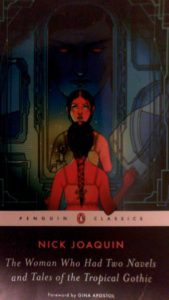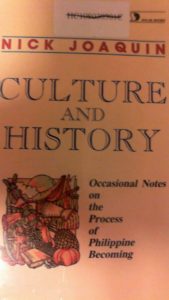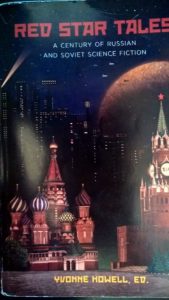Nick Joaquin: Polyphonous Atemporality: Dual Post-Colonialism in Nick Joaquin’s Short Stories.
Reflections for the College Language Association 2018 Conference
Chicago, Illinois
B. Amarilis Lugo de Fabritz, Ph. D.
Master Instructor, Russian
Howard University
The transition from colonialism to post-colonialism in the twentieth century raises soe curious questions to the populations left behind in the lands formerly classified as colonial holdings, such as Latin America and the Philippines. Among the most interesting:
a. How do we evaluate the cultural influence of colonial powers on the populations left behind?
b. How do we evaluate the cultural and historical shifts brought forth by the colonial past?
Nick Joaquin provides an interesting case study for these two questions in Philippine literature. He wrote both critical-theoretical articles on the nature of Philippine history and culture, as well as creative fiction that created a vision of colonial influence on Philippine culture as a case of polyphonous atemporality, where multiple cultural influences caused a cultural reality unmoored from standard unlinear temporal ideas.
My presentation will look at one of Nick Joaqun’s theoretical concepts, the way that colonial languages can be used as tools to reflect historical cultural transitions. This concept, combined with an application of the Bakhtinian concept of heteroglossia, when applied to his creative writings, reveal how he manages to create a polyphonous atemporal narrative, where his characters negotiate through different colonial cultural constructs to reflect on contemporary hybrid Filipino reality.
I, NICK JOAQUIN’S WRITINGS
Nick Joaquin wrote extensively on the issue of culture and colonialism. His essay “Culture as History,” in particular, presented his view on how to negotiate Philippine contemporary culture with its colonial past. He differentiated among Asian, Spanish, and English colonial legacies. He makes various provocative observations,
I. Colonial legacies, which have been absorbed by the Philippines, have become tools in the progress of Filipino culture.
“Here would be no need to save national pride, since this would be purely Philippine History: the Filipino at stage center; with the alien intervenor himself counting as one of the tools with which we acted and to which we reacted. Even Christianity can be included among these tools, not in any derogatory sense but in the McLuhan meaning when he says that clothing, money, the house and the road are tools and that all such tools are “media of communication.” Thus we could solve the problem that most irks us about this epoch: the presence of the alien intruder, who would then be reduced, not without honor, to the role of medium. “
II. The Philippines become a place where the conflict between East and West play out in ways that echo Slavic debates between Westernizers and Slavophiles.
“This is recognized even by those who deny it, as when they assert that 1521 marked a deviation from what might have been our true history; or when they fume that we were Christianized at the cost of our “Asian” soul; or when they argue that if the Philippines had only been completely converted to Islam by the 16th century, the Philippines were already Buddhist, or Taoist, or Hinduist, or Confucianist, or Shintoist, the West would have conquered us in vain, because, being already formed by the media of the great civilizations of the East, we would be in little danger of deviating from the Asian form.
If it be true indeed that we were Westernized to the cost of our Asian soul, then the blame must fall, not on the West, but on Asia.”
III. A dual cultural process emerges, polyphonous atemporality.
“Our problem is in the process, or rather, in history as becoming, for what we cannot accept is that we became Filipino any more than we accept that we became Asian. (If you are of Asia, then you are Asian, period.) Even if we do recognize that a double process was in movement during the colonial era, one process tending to Asianize us and the other to Westernize us, we do so only to discriminate between them and to aver that the former produced what may be called our pancit and lumpia culture, which can be accepted as Philippine because it was Asian, and the other produced our adobo and pan de sal culture, which is Creole and therefore to be rejected as corruption. From a practical existential viewpoint, either process seems as Filipino as the other, and both to be now a single culture in which they cannot be distinguished apart, being too interfused with each other and with everything else in the culture,..”
Nick Joaquín, “Culture as History,” Culture and History: Occasional Notes on the Process of Philippine Becoming. Metro Manila: Solar Publishing Corporation, 1988 1-26
English comes to occupy a special place among colonial languages, since, in his eyes, it is only that literariness as such truly emerges as a tradition in Philippine writing.
“Our fictionists in English are, in fact, the very first group of Filipino writers to be read simply for the sake of reading, or, rather, for the pleasure, the delight, of reading.”
Joaquin, Nick. “THE FILIPINO AS ENGLISH FICTIONIST.” Philippine Quarterly of Culture and Society, vol. 6, no. 3, 1978 Pg. 121-122
These comments seem to harmonize in a curious manner with Mikhail Bakhtin’s theory of heteroglossia, разноречие.
“Literary language – both spoken and written – although it is unitary not only in its shared, abstract, linguistic markers but also in its forms for conceptualizing these abstract, linguistic markers, it itself stratified and heteroglot in its aspect as an expressive system, that is, in the forms that carry meaning… Thus, at any given moment of its historical existence, language is heteroglot from top to bottom: it represents the co-existence of socio-ideological contradictions between the present and the past, between differing epochs of the past, between different socio-ideological contradictions between the present and the past, between differing epoch of the past, between different socio-ideological groups in the present, between tendencies, schools, circles, and so forth, all given a bodily form. These “languages” of heteroglossia intersect each other in a variety of ways, forming new socially typifying “languages.””
Mikhail Baktin, “Discourse in the Novel,” 288,,291
Bakhtin, M. M. The Dialogic Imagination: Four Essays by M. M. Bakhtin. Holquist, Michael, ed. Caryl Emerson and Michael Holquist, trans. Austin: University of Texas Press, 1996
Putting these all together, we can start detecting the emergence of an intentional polyphonous atemporality in Nick Joaquin’s fictional writing, My analysis will focus on the short story “May Day Eve,” which is available in his recently published Penguin anthology, but which is also available via JSTOR from:
Joaquin, Nick. “May Day Eve.” The Transatlantic Review, No. 5 (December 1960), pp. 26-35
“May Day Eve” is a short story populated by multiple points of view and multiple timelines. This multi-voiced, heteroglot in the Bakhtinian sense, and multi-temporal narrative reflects the co-existence of what Joaquin sees as the three main cultures that constitute the Filipino tradition: indigenous Philippine, Spanish Catholic conquista, and English. While Spanish and indigenous ideologies fight for domination in this cultural space, it is the bending of English stylistic and grammar rules that become the main tool for displaying the, in the case of his story, literally magic effect of the polyphonous ideologies that play off of each other like so many musical cords, that constitute Filipino awareness.
The story revolves around a legend presented by the oldest woman we see in the story, old Anastasia.
“And it was May again, said the old Anastasia. It was the first day of May and witches were abroad in the night, she said – for it was a night of divination, a night of lovers, and those who cared might peer in a mirror and would there behold the face of whoever it was they were fated to marry, said the old Anastasia as she hobbled about picking up the piled crinolines and folding up shawls and raking slippers to a corner while the girls, climbing into the four great poster-beds that overwhelmed the room, began shrieking with terror, scrambling over each other and imploring the old woman not to frighten them. ‘Enough, enough, Anastasia! We want to sleep!’
‘Go scare the boys instead, you old witch!’
‘She is not a witch, she is a maga. She was born on Christmas Eve!’
‘St. Anastasia, virgin and martyr.’
‘Huh? Impossible! She has conquered seven husbands! Are you a virgin, Anastasia?’
‘No, but I am seven times a martyr because of you girls.’”
Nick Joaquin, “May Day Eve” The Transatlantic Review, No. 5 (December 1960), pp. 27
Here we see some of the more common features of Joaquin’s style. Sentences related to dialogue delivery prove consistently short. However, those focusing on descriptive passages tend to blur the rules of normative style and grammar by running on to amazing lengths. The tense play of competing ideologies, much like the tense relationship among second or sixth notes in a chord, manifests itself in the flow of these not safe for grammar school English sentences. In this passage, for instance, Anastasia carries out the rational legal functions of a European nanny, while conveying to her charges the old traditions of pre-Christian Philippines.
“‘Let her prophesy, let her prophesy! Whom will I marry, old gypsy? Come, tell me.’
‘You may learn in a mirror if you are not afraid.’
‘I am not afraid, I will go!’ cried the young cousin Agueda, jumping up in bed.
‘Girls, girls – we are making too much noise! My mother will hear and will come and pinch us all. Agueda, lie down! And you, Anastasia, I command you to shut your mouth and go away.’
‘Your mother told me to stay here all night, my grand lady!’
‘And I will not lie down!’ cried the rebellious Agueda, leaping to the floor. ‘Stay, old woman. Tell me what I have to do.’
‘Tell her! Tell her!’ chimed the other girls.
The old woman dropped the clothes she had gathered and approached and fixed her eyes on the girl. ‘You must take a candle,’ she instructed, ‘ and go into a room that is dark and that has a mirror in it and you must be alone in the room. Go up to the mirror and close your eyes and say:
“Mirror, mirror,
Show to me
Him whose woman
I will Ье!”
As we get carried away by the unexpected twist to the fairy tale formula “mirror, mirror, on the wall” we also see the confused presence of possibly Christian, possibly pagan verb “prophesy,” In this case the maga gitana reveals the magic space of the mirror.
This mirror, and the text surrounding the mirror, inhabits s space occupied by what Slavic ethnographers called dvodverie, cultural practices derived by the simultaneous manifestation of dual ideological systems. Anastasia is considered a saint for having been born on Christmas Day and surviving seven husbands, but at the same time she is the maga opening the magic boundary of the mirror on May 1.
The mirror, in turn, becomes a spot that bends time and space, and thus marks the effects of the cohabitation of both belief systems. The mirror literally becomes a place of reflection on the present, the past, and the future. The ritual in front of the mirror repeats itself four times in the course of the text, the first with young Agueda, the second with old Agueda relating the story to her daughter, then with young Don Badoy Montiya, Agueda’s eventual husband, repeating his version of the ritual, and then old Don Badoy reflecting on Agueda’s passing.
Each of these repetitions displays one of Joaquin’s most distinctive stylistic features: the unannounced, instantaneous temporal shift.
“The mother’s lips curled. ‘Yes, he did! But, alas see them at that time. All I could see were his flashing eyes, his curly hair and moustaches.’
‘And did he speak to you, Mama ? ‘
‘Yes . . d. Yes, he spoke to me,’ said Doña Agueda, and bowing her greying head, she wept.
‘Charms like yours have no need for a candle, fair one,’ he had said, smiling at her in the mirror and stepping back to give her a low mocking bow. She had whirled around and glared at him and he had burst into laughter.
‘But I remember you!’ he cried. ‘You are Agueda, whom Inleft a mere infant and came home to find a tremendous beauty, and I danced a waltz with you but you would not give me the polka.’
‘Let me pass,’ she muttered fiercely, for he was barring her way.
‘But I want to dance the polka with you, fair one,’ he said.
So they stood before the mirror; their panting breath the only sound in the dark room; the candle shining between them and flinging their shadows to the wall. And young Badoy Montiya (who had crept home very drunk to pass out quietly in bed)
suddenly found himself cold sober and very much awake and ready for anything. His eyes sparkled and the scar in his face gleamed scarlet.”
The presence of practices that reflect the existence of a Philippine presence of двоеверие (dvoeverie), the marked presence of the performance of a specifically West European form of masculinity, as reflected in desirability being directly proportional with European education — don Badoy had just returned from study in Europe, Agueda’s higher space in society being reflected in her mastery of multiple European dances such as the waltz and the polka, all of these prove fruitless in the attempt to match these social coequals. Their final cultural compatibility derives from their ability to execute the old, pre-Christian ritual in front of the mirror.





